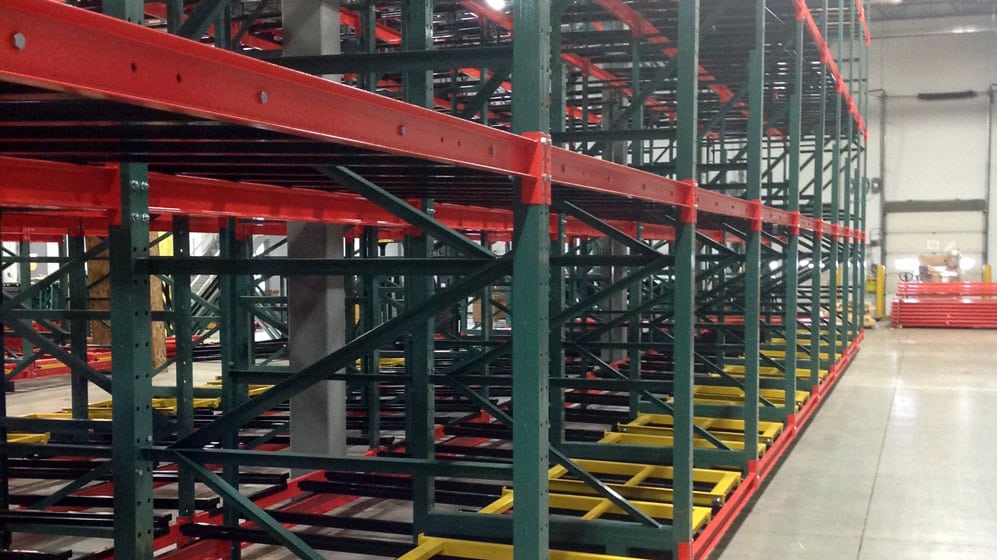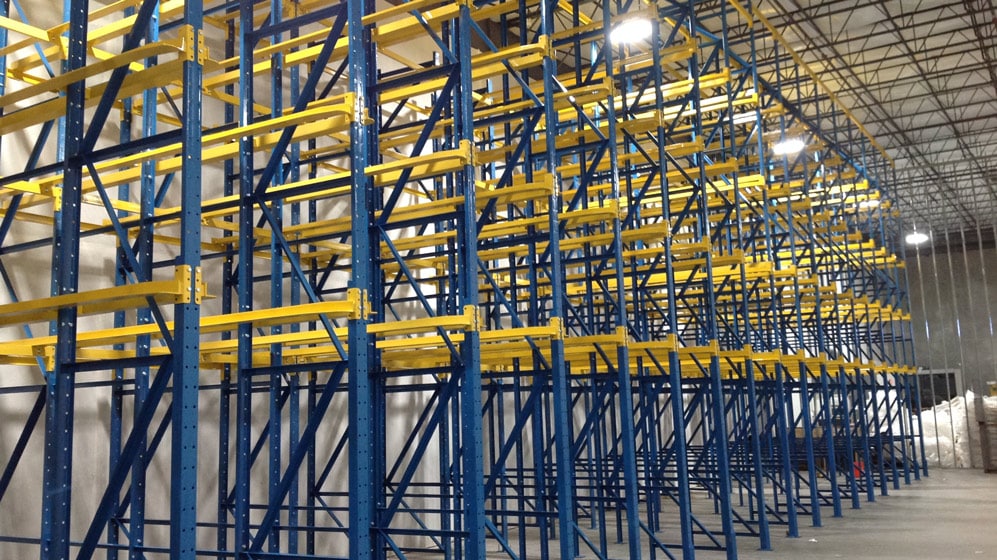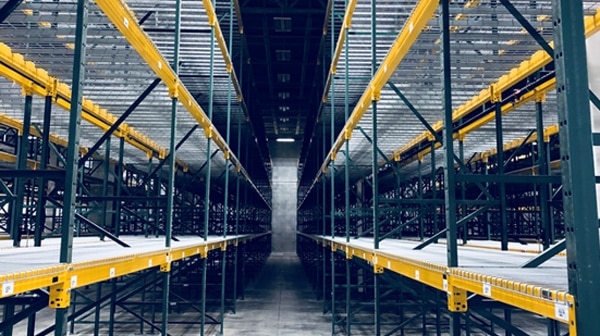Maximizing storage space is critical when you need to grow your operations but aren’t ready to expand your warehouse. Without the space to support growth, you may find your current infrastructure cannot accommodate increased inventory or larger orders.
Investing in warehouse racking systems to optimize existing floor space can help alleviate these challenges. Learn more about your options and how RMH Systems can help you work smarter and more efficiently.
Racking in a Warehouse: What It Is and How It’s Used
Warehouse racking is the system of storing goods on pallets, in stackable frames or other support structures. Racks are typically made from steel and can be configured to fit any size and type of warehouse space.
In modern warehouses, shelves are designed for maximum efficiency by using adjustable levels that can be adapted to fit different types of products. Warehouse racks can also be designed with safety features to protect warehouse workers and prevent accidental damage to stored goods.
Additionally, various types of shelving systems are available to help organize different types of warehouses and increase efficiency in the picking process. With proper racking, warehouses can maximize storage capacity and ensure that goods remain secure until they reach their final destination.
Racking vs. Shelving—What’s the Difference?
Warehouse rack and shelving are two common types of warehouse storage solutions. Both racking and shelving make warehouses more efficient by increasing accessibility and maximizing storage space.
Warehouse Racking Systems
Racks are designed to maximize storage capacity. They typically have adjustable levels that make them suitable for a variety of goods, such as large boxes or items with irregular shapes. You may also hear them referred to as warehouse pallet racks, since they have the capacity to store full pallets.
Warehouse Shelving Systems
Shelves, on the other hand, are designed to organize smaller items and provide easy access for quick product retrieval. They can also be adjustable, allowing for efficient storage of a variety of products.
Pallet Rack vs. Warehouse Rack—What’s the Difference?
Pallet rack and warehouse rack are often used interchangeably; however, they are slightly different.
Pallet Rack
Pallet racking typically refers to a specific type of storage system that includes adjustable shelves or frames in order to accommodate pallets of different sizes and weights.
Warehouse Rack
Warehouse racks refer to any kind of racking used for storage in a warehouse, including pallet racks but also other types such as cantilever or drive-in racking.
How to Choose a Warehouse Racking System
Choosing the right warehouse racking system is an important decision that requires careful consideration of factors such as cost, safety and efficiency. Here are a few things to keep in mind:
- Your warehouse size and what types of products you need to store.
- The type of racking that best fits your needs, including adjustable levels or specialized shelving designed for certain products.
- The cost of the various racking systems and consider any additional safety features that might be necessary for your warehouse.
- A qualified rack expert should verify your floor slab is sufficient to support the load from the rack, and that any local seismic forces are taken into account in the rack design, as two-thirds of the United States has seismic activity that affects rack design.
With careful consideration and research, you can find the right racking system to meet your warehouse requirements.
Types of Racking Used in a Warehouse or Distribution Center
Each type of warehouse racking has its own advantages and should be selected based on the specific requirements of the warehouse.
Selective Pallet Racking
Selective pallet rack is the most common type of racking for warehouses.
- Single deep pallet rack with an aisle for a lift truck.
- Available in various heights and depths to meet your needs.
- Recommended when you have many pallets with one SKU per pallet.
Pushback Racking

Pushback rack is similar to a selective pallet rack system, but allows you to store up to six pallets deep. It’s recommended for pallets with one SKU.
Pallet Flow Rack
Pallet flow racking involves putting pallets on rollers and loading them from the back, so gravity flows them to the front.
- First-in, first-out approach is ideal for food and beverage companies.
- Available in different heights and depths to provide dense storage.
Drive-In Drive-Through Racking

A drive-in drive-through racking system is best for manufacturers who are making full truckload quantities of a single SKU. It’s an economical option for high-density storage for a low number of SKUs.
Cantilever Rack
With no front columns, cantilever racking makes loading and unloading easier for long, bulky or oddly shaped loads, such as lumber.
Carton Flow Rack
Carton flow racking is designed for rapid retrieval and replenishment of products stored in cartons.
- Installed on shelving units or other racking systems.
- Functions as a gravity-fed flow system, allowing items to move smoothly down the rack.
- Increases efficiency and accuracy of automated order fulfillment processes while still maintaining the flexibility of manual order picking.
Overhead Dock Door Racking
Overhead dock door racking helps you maximize storage when you’re in the last phase of growth before building a new building. This type of racking is great for empty pallets or corrugated storage that can clutter loading docks.
Other Warehouse Storage and Fulfillment Systems
- Pick module system—paired with a conveyor system to enhance productivity in order filling. Available in single- or multi-level configurations.
- Vertical storage carousel—automates the goods-to-operator process. Conserves square footage by storing parts or inventory in the carousel, which brings them to the operator.
- Industrial modular cabinets—ideal for fast retrieval during order picking.
- Automated storage and retrieval system (ASRS)—racking is connected to a computer-controlled system that moves items to and from the storage locations.
Other Considerations When Choosing Warehouse Racking
Pallet Size
Pallet size affects the type of racking you need. If your facility uses smaller pallets, then more racks may be required in order to accommodate all of the items.
Order Data
When determining what type of warehouse racking is best for a particular facility, it is important to consider the specific needs of your business.
This includes looking at order data in order to assess how frequently different products are ordered, as well as evaluating any potential increases in demand. Knowing which items will be stored and how often they need to be accessed can help inform the selection of the right type of storage rack.
On-Site Material Handling Equipment
For example, if there are forklifts, conveyors or overhead cranes on-site, they may require pallet racks that are specifically designed to accommodate their movement.
Safety Devices
Warehouse racking should be outfitted with appropriate safety devices in order to minimize the risk of injury or damage. This includes guardrails, netting and other barriers to prevent items from falling off shelves.
Warehouses should use special anchors or fasteners to help secure racks that are exposed to wind, vibrations and earthquakes, if appliable. Aisle should also be clearly marked, and shelves should be labelled in order to reduce the risk of collisions or other accidents.
By taking the time to properly secure and equip racks with the right safety devices, warehouses can help ensure that their staff remain safe while on the job.
How Much Warehouse Racking Costs
The cost of warehouse racking depends on the type and size of racks needed. A selective pallet rack system is typically the most cost-effective option, while specialized options can be more expensive. In most cases used or refurbished rack is the same or similarly priced to new rack.
Ultimately, the cost of warehouse racking can vary significantly based on the specific needs of each individual facility. It is important to consider not just the initial cost, but also the potential savings in terms of increased productivity and efficiency when choosing the best storage racks for a particular warehouse.
At RMH, our warehouse racking team specializes in solving storage issues. Whether you need a standard or custom design or need to redesign your warehouse, we can help! Contact us today for a free consultation.
